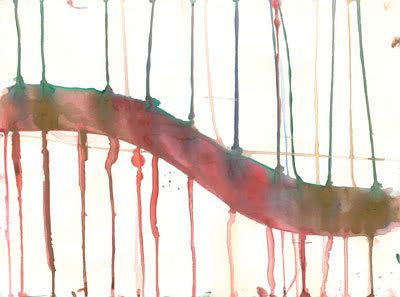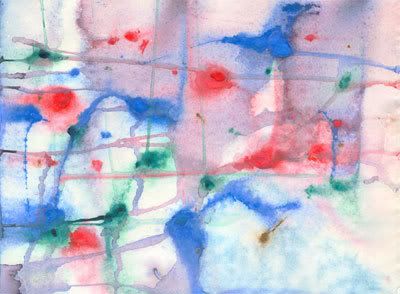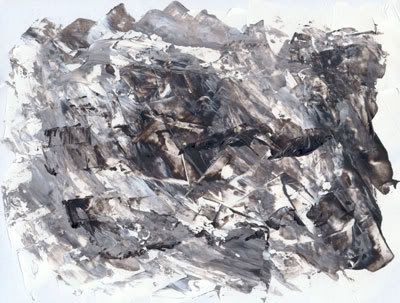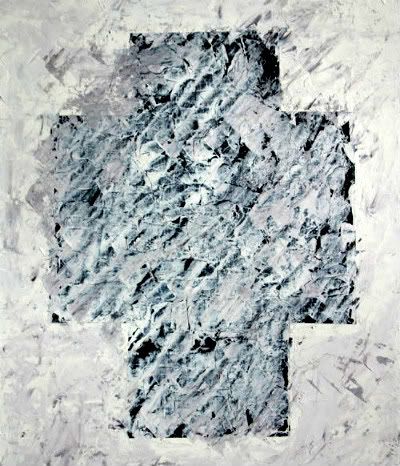I must confess that I wasn't especially looking forward to this past Friday night's class at the St. Louis Art Museum because we were going to be doing collages. I find the collages in "the Immediate Touch" exhibit to be not particularly interesting, and I've done work in very similar style in the past. One of the things that I find fascinating about the class are the number of students who will ignore the artwork in the exhibit and merely produce work in a style with which they are already familiar. The point, it seems to me, of each week's particular exercise is to challenge each student to take a step beyond what they are already comfortable with doing. I went into the class dead-set on doing something I'd never done before.
For my first collage, I decided to do a very minimalist collage with only a few elements and very few marks. My first piece was done in like five minutes so I kept poking at it and adding marks. Fortuitously, I spilled my container of India ink on my work surface and, while cleaning in up, decided to use an ink-soaked paper towel to make marks on a blank piece of paper for the basis of another collage. I also soaked the edge of my first collage in the spilled ink.
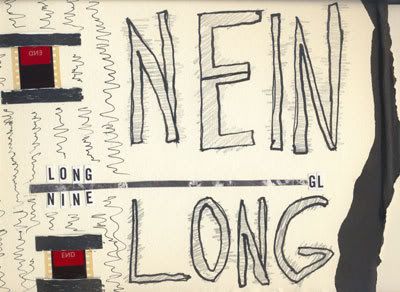
T. Renner, "Long Nine GL," 2008, collage, ink on paper, 9.5" x 13".
I admit that I spent an inordinate amount of time working on the background for the next collage, adding marks with red watercolor. I just wasn't feeling anything until I went upstairs and looked at the collages in "the Immediate Touch" exhibition. Something then clicked and I rushed back to my collage-in-progress.
I had hoped to find a news-magazine to get some photos from but all that was at hand was a Sotheby's catalog of African folk art. It was cool but I couldn't see how I could use it until I came across the portrait of the guy who had collected it. I feel bad that I was more interested in doing the work than taking notes so I didn't make a note of the collector's name. In an instant, I decided to put a weapon in his hand and to cover the collectors face except for his eyes with a ritual mask. I found a nice object that I could tear up and use to cover the text that appeared on at the bottom of the collector's portrait. Finally, I found the "mug shots" of the Sotheby's staff. It felt wrong to have their names appear so I cross them out with India ink and then decided to further their anonymity by blacking out their eyes.
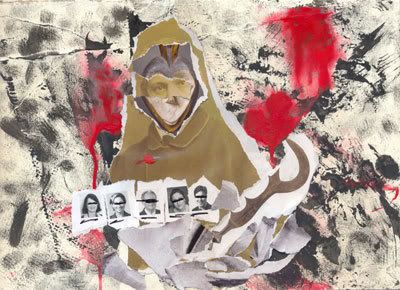
T. Renner, "Red Sotheby's Faction," 2008, collage, ink, and watercolor on paper, 15.25" x 11".
All of the elements -- the blood red splotches, the weapon, the defaced mug shots, the mask over the collector's face -- add up to one disturbing and threatening piece.
As I was finishing the piece, I realized that it could be read as a statement about the appropriation of African folk art by the western art establishment. The mug shots reminded me of the Baader-Meinhof group of the 1970's, who carried out a series of kidnappings and killings in Germany. As I told the instructor, if I were the members of the Sotheby's staff in my collage I would be very frightened.
Self-grade: A.










